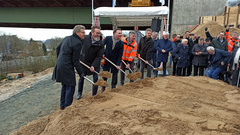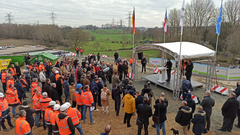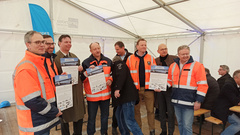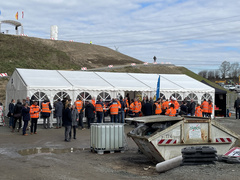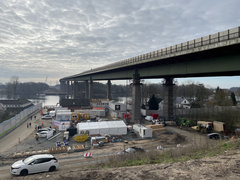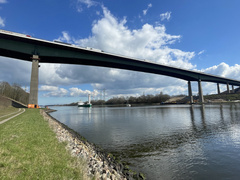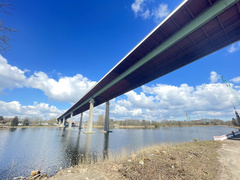Yesterday, groundbreaking at Rader viaduct started the official construction of the first partial structure. Among others, Schleswig-Holstein transport minister Claus Ruhe Madsen and parliamentary undersecretary at the transport ministry Oliver Luksic attended the ceremony. In their speeches, both highlighted the cultural and economic importance of the bridge, which will significantly improve the transport connection between Germany and Denmark.
Rader viaduct leads motorway A7 over the Kiel Canal and Bogenstedter Strait. The bridge, initially opened in 1972, plays a central role for the traffic link to Denmark and Scandinavia, and is Germany’s second largest steel road bridge. A structural analysis resulted in a remaining life span of the viaduct until 2026. As an economic reinforcement of the structure was deemed impossible, the bridge has to be replaced. For the implementation of the project, state company DEGES charged SSF Ingenieure in a joint venture with Schüssler-Plan with preliminary and draft design as well as approval design.
Basic evaluation started in 2015. Approval design and the plan approval procedure have by now been completed and preparatory works at the construction site are finished. As approval design was already completed during tendering, construction works started right afterwards in January 2023. The groundbreaking ceremony now officially launched the construction. In this context, all project partners signed the “cooperation charter”, committing to a collaborative project execution.
The first partial structure (lane towards Flensburg) is planned to be finished by 2026, east of the existing bridge. Subsequently, the old structure will be demolished, and traffic temporarily led over the new four-lane structure. Meanwhile, the western part of the viaduct will be newly built. The second part will probably be finished by 2030 and traffic will roll on six lanes over the new bridge.
More information about the technological implementation is compiled in our project entry.
